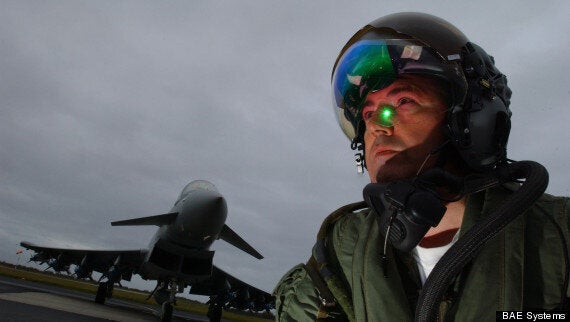Mark Bowman is a man who doesn't mince his words, which is just as well because ultimately that -- and an almost otherworldly ability to fly a plane -- is his job.
Bowman is Chief Test Pilot for BAE Systems; the largest defense and aviation company in the UK and indeed one of the largest in the world.
At the heart of the company's aviation segment is Mark, a man who has been flying Harriers since he can remember and was instrumental in testing probably the most advanced aircraft ever built, the X-35 Joint Combat Fighter.

We're speaking to him at the Farnborough International Airshow where every two years, multi-national aviation and defense contractors will turn up and show off the latest innovations in aerospace, whether it's missiles, fighters, airliners or satellites, they're all here.
BAE and Mark are here to talk about Striker II; arguably the most advanced helmet ever built and easily one of the most futuristic pieces of equipment we've ever seen, to Mark, and every other pilot out there though it's much more than that.
"Getting a good helmet is almost as important as the Heads Up Display. We’re moving into significant, almost revolutionary changes here in cockpit design and really even now where we are, we’re just on that springboard into where we’re going to be taking cockpit design in the future."
For those of us that aren't aviation experts, Striker II is significant because it places an entirely virtual world on the visor of the helmet, it's a world within which you can see targets hundreds of miles away, see live satellite feeds, even see in the dark. Its been a long time coming.
"I was the Ministry of Defence's project test pilot for the Harrier at the time at Boscombe Down and they were interested in introducing a night-attack capability in the Harrier. One of the things that was essentially missing was what I’d call a ‘true 24 hour capability’ which was the ability to put night vision on the goggles, in fact it was provisioned originally but the technology hadn’t really caught up to be honest."
"Putting analogue cameras on a [digital] helmet just didn’t work so we really had to wait for the technology to catch up to where we are now."
"The Harrier was incredibly successful as a night attack platform but moving that on into the Typhoon era with the air combat capability of that aircraft we started needed something better and hence the formation of the STRIKER family."
Striker may sound like the realms of 'Iron Man' and Robocop but the military is using a whole range of technologies that are far ahead of what we see as consumers, thanks in part, to the huge sums of money that are spent on defence.
"We already have voice input on Typhoon for example, the aircraft knows my voice; anything a mouse can do -- which is essentially how you control an aircraft with HOTAS (Hands On Throttle And Stick) -- you can also replicate with voice so it’s of course a lot quicker and more accurate."
Bowman has been testing these flying supercomputers for nearly 30 years, having completed a degree in aeronautics he then went on to do three tours in Harrier Jump Jets and one tour as a Harrier test pilot.
Unsurprisingly, and as you absolutely expect, he's cripplingly modest about it.
"I suppose there was this desire of molding together the theoretical side and the practical side. I mean I was most probably lucky as well at having flown the Harrier and had done reasonably OK on that so I was then able to realise that capability...to be honest I found it tougher to get into test pilots school than it was to get into the RAF in the first place."
"At the end of that it gives you an idea from taking aviation you thought you knew about which is about here to something that is absolutely enormous."
For Mark though the flying wasn't a problem, one of the biggest tests was that of adding another string to the already multi-skilled bow that was flying an enormous metal wedge of fire.
"They teach you not to stop talking, especially when things start getting tough. The first thing that happens when things start going wrong is that people stop talking, half the skill of the test pilot is to talk, and then telling people what his hands, feet, eyes and everything else are doing."
He is of course referring to the very occasional moments when something goes wrong; arguably the one drawback of being a test pilot. Bowman suggests that this can have a dual effect on pilots, with some people enjoying flying both in and out of the job and others looking to escape. He's most definitely the former.
"You’d think most probably that people doing this sort of thing are just total aviation people well we’re not, I have a life outside aviation."
So how does a human unwind after having flown a multi-billion dollar piece of equipment? The answer may not be what you were expecting.
"I love cooking, I like cooking, I like drinking wine. I like playing with my kids and I’ve got a little cottage down in Cornwall, so I can sit there, on the beach and listen to the Fisherman’s Friends singing about twenty yards from the door of my house with a nice pint of Cornish beer in my hand, that’s how you unwind."